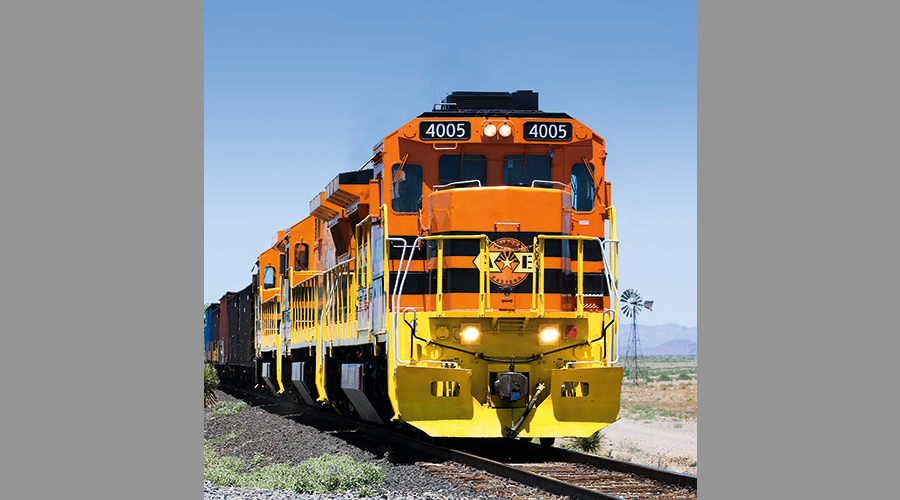Stay updated on news, articles and information for the rail industry
February 2011
Rail News: Short Lines & Regionals
Short lines: NASA Railroad's future in question
by Julie Sneider, Assistant Editor
Later this year, the National Aeronautics and Space Administration (NASA) is scheduled to launch the final space shuttle mission, bringing to a close the agency's 30-year space shuttle program.
What that program's end will mean for NASA's short-line railroad at Kennedy Space Center has yet to be determined.
"That's the $64 million question," says George Diller, a NASA spokesman.
As the shuttle program winds down to its final launch this summer, the space center's basic infrastructure, which includes the NASA Railroad, is under review, Diller says.
For the past 30 years, the short line has been an important component of the shuttle program, providing a system for transporting the solid rocket boosters from ATK Aerospace Systems' Utah manufacturing plant to the space center on Florida's east coast.
Private Railroads Play a Part
The solid rocket boosters are transported in eight-piece segments during a seven-day journey over track owned by Union Pacific Railroad, Kansas City Southern, Norfolk Southern Railway, CSX Transportation and Florida East Coast Railway (FEC), says Dave Hoffman, who managed the NASA Railroad for 13 years until he retired in 1996.
NASA owns three SW-1500 locomotives, but the rocket booster segment cars are owned by UP, CSXT, KSC and FEC, says Diller. Most of the rolling stock is standard operating equipment for freight rail, but some of the rocket-booster structure cars were designed and customized by NASA with Hoffman's input.
The railroad dates to the U.S. space program's early days, and FEC has a long history with the short line, Hoffman says. In 1963, FEC built a 7.5-mile connection from its mainline north of Titusville, Fla., across the Indian River to the Kennedy Space Center, which was under construction at the time.
The FEC connection joined 28 miles of NASA-built track at the Wilson Corners junction, just north of the space center. FEC also built two seven-track yards: Jay Jay Yard at the mainline interchange, and Wilson Yard. At Wilson Corners on the space center's northern end, the railroad splits into two, nine-mile stretches of track. One segment leads to the space center's vehicle assembly building and launch pad areas; the other, to the Cape Canaveral Air Force Station.
By the time the shuttle program took off in the 1980s, NASA Railroad's mainline between the FEC interchange north of Titusville and the space center's vehicle assembly building required upgrading, Hoffman says. As originally built, the track wasn't equipped to accommodate the weight of the 12-foot-wide, 150-ton rocket-booster segments.
So, NASA contracted FEC to rebuild the mainline with heavy welded rail, concrete ties and granite ballast to meet safety and weight requirements. The reconstruction helped ensure the track would survive the area's salty air and humid climate, Hoffman says.
"Some of that track has been out there since the late 1980s and all we've had done [to maintain it] is spray for weeds," he says.
The railroad has been used to haul other hazardous cargo, such as chemicals used in making rocket propellant, Air Force Titan rockets, Navy Trident missiles and shuttle booster segments for the Ares I-X flight test.
Although President Barack Obama has said he's committed to NASA's future and its space-exploration mission, he's also called for expanding commercial companies' involvement in space transportation, including transporting astronauts to the International Space Station.
In December 2010, Space Exploration Technologies Corp. (SpaceX) used Cape Canaveral Air Force Base to launch an unmanned rocket for testing in orbit — a first for a privately owned company. The rocket successfully parachuted back to Earth three hours later.
How the NASA Railroad might be used to serve commercial businesses like SpaceX is part of NASA's ongoing study.
"We are reviewing what the long-term requirements are for NASA, what requirements the Department of Defense will have, and what the needs of the commercial launch industry may be," Diller says. "We don't expect we'll have all the answers to that until late in 2011 or sometime in 2012."
Keywords
Browse articles on short line NASA NASA Railroad space shuttleContact Progressive Railroading editorial staff.


 2025 MOW Spending Report: Passenger-rail programs
2025 MOW Spending Report: Passenger-rail programs
 Gardner steps down as Amtrak CEO
Gardner steps down as Amtrak CEO
 Guest comment: Oliver Wyman’s David Hunt
Guest comment: Oliver Wyman’s David Hunt
 Women of Influence in Rail eBook
Women of Influence in Rail eBook
 railPrime
railPrime







